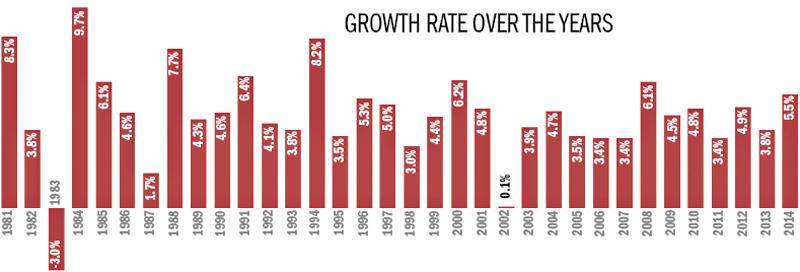GDP to contract 1.1pc if trade disruption continues
Kathmandu, November 20
The ongoing trade disruption will shave off up to Rs 53 billion from the gross domestic product of this fiscal year and will reduce the size of the economy by 1.1 per cent (at basic price) if the situation continues to remain the same till the first half of the fiscal, says a latest report of the central bank.
Nepal Rastra Bank made the dismal projection citing high chances of shrinkage in agriculture, industrial and services sectors this fiscal because of ‘disruptions at border points and unofficial Indian blockade’.
If the prediction made by the central bank comes true the country will post negative economic growth for the first time since 1983.
The government had earlier targeted economic growth rate of six per cent for this fiscal assuming fast-paced post-earthquake reconstruction works.
But the ongoing trade disruption has not only affected reconstruction activities but all the sectors of the economy, says the preliminary draft of the report titled ‘Impact of Undeclared Blockade on Nepal’s Economy’.
If the disruption continues till the first half of this fiscal, or till mid-January, agriculture sector will shrink by 0.5 per cent, says the draft report.
Agriculture sector is expected to post a negative growth because of five per cent fall in production of paddy, which makes a contribution of 21 per cent to the agricultural GDP, and 10 per cent decline in output of maize, which makes a contribution of seven per cent to agricultural GDP.
Production of paddy and maize are expected to fall this fiscal because of scant rainfall and shortage of chemical fertilisers and pesticides due to trade disruption at border points. “If the supply of chemical fertilisers and pesticides does not normalise soon, wheat production will also fall,” says the report.
The impact of prolonged disruption in trade is expected to be the worst in the industrial sector, which is likely to contract by 2.5 per cent this fiscal year, says the draft report.
The industrial sector is expected to take a hit because of closure of factories in the Tarai, where protests are taking place, delay in construction of hydropower plants and other physical infrastructure, such as roads, and the inability to add more electricity to the grid.
Among others, services sector, which makes a contribution of 53 per cent to the GDP, will be squeezed by one per cent if trade disruption continues till the first half of this fiscal, says the report.
Services sector will suffer because of interruption in movement of vehicles due to fuel shortage. “It is said only 10 to 25 per cent of vehicles are currently operational,” says the report.
Also, hotels have reported room occupancy rate of less than 20 per cent during the peak tourist season, while many schools and colleges have remained shut because of lack of fuel to transport students.
“So, the trade disruption triggered by protests in the Tarai and India’s unofficial blockade has been even more damaging to the country than the earthquakes of April and May,” says the report.
Yet, the report says the economy may expand by 1.5 per cent if supply of fertilisers and pesticides normalises, reconstruction works and construction of various physical infrastructure start immediately, engagement of the private sector in industrial activities increases, and trade of other merchandise goods normalises.






